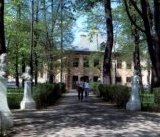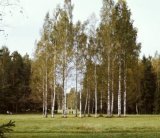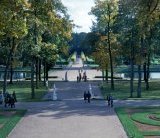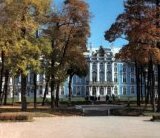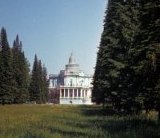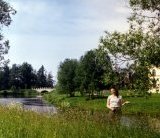 |
QUICK SEARCH
MO PROJECTS:
Africa
Asia/Pacific
Mesoamerica
North America
South America
General Taxonomy
Photo Essays
Training in Latin
America
MO RESEARCH:
Wm. L. Brown Center
Bryology
GIS
Graduate Studies
Research Experiences
for Undergraduates
Imaging Lab
Library
MBG Press
Publications
Climate Change
Catalog Fossil Plants
MO DATABASES:
W³MOST
Image Index
Rare Books
Angiosperm
Phylogeny
Res Botanica
All Databases
INFORMATION:
What's New?
People at MO
Visitor's Guide
Herbarium
Jobs & Fellowships
Symposium
Research Links
Site Map
Search
RUSSIAN LANDSCAPING STYLEIf one wants to create a garden or garden feature using Russian plants, it would be logical to turn to Russian garden and landscape traditions. It is very difficult, if indeed at all possible, to reconstruct ancient Russian gardens. Nevertheless, it is of interest to elucidate the role ornamental plants played in Russian gardens and the kind of landscaping styles these gardens used to have. According to Dubjago (1963), Kurbatov (1916) and Vergunov and Gorokhov (1996), ornamental gardens first appeared in Russia in the cities of Kiev, Suzdal, Vladimir, Moscow and Novgorod between the 11th and 15th centuries. Ornamental gardens became more common in the 16th and 17th centuries. None of these gardens has survived, and only fragments can be seen. Analysis of these remains has led experts to conclude that ancient Russian gardens were designed according to a formal style that followed certain geometrical rules. Fruit trees and shrubs played a major role in these gardens and birch and spruce were grown together with many flowers. Flowers were predominant in monastery and "hanging" gardens. The latter were constructed on the roofs of the utility buildings at the level of the living rooms. Peonies, carnations, red roses and white and yellow lilies were among the popular herbaceous ornamentals. There were many country estates in Russia, and each had a large garden. The house was situated in a place with a view of the environment and the garden itself was a part of the surrounding landscape. Groves of one kind of tree were popular. Around Moscow there were many gardens that consisted of only one kind of tree including birch groves, oak groves, pine groves and others. Fragrant herbs and shrubs were obligatory additions and that is why mints and junipers were especially popular. The oldest extant gardens are the garden ensembles in St. Petersburg, which date back to the beginning of the 18th century. All these gardens were created under Dutch, French, Italian and German influences. However, all the foreign landscape designers brought in by Peter the Great took into consideration the national tradition and the natural landscape. As a result, a new, unique Russian style was created; the earlier formality was not swept away, but allowed to co-exist with the new landscaping. The most remarkable thing is that the palace and the garden are situated in the most favorable place. The architects used the surrounding landscape very skillfully. Thus, the Summer Garden and the Summer Palace in St. Petersburg were built right on the bank of the Neva River. The Summer Garden is as old as the city; it was founded in 1704, a year after the founding of St. Petersburg. The very first plan of the garden was made by Peter I and it is still kept in the City Archive. Peter the Great invited the French architect Le Blond, the Russian architect M. Zemtzov and the gardeners P. Roozen and I. Surmin to participate in the work. The Summer Palace of Peter I was built in 1714 in the Summer Garden and was designed by
The 1750s were the years of the greatest flourishing of the Summer Garden because the formal parks were in highest fashion and most favored in that period of time in Russia. The architect Rastrelli brought the ensemble of the two Summer Gardens to perfection, widening the original composition of Le Blond. In the 1780s embankments for traffic were built between the Summer Garden and the Neva. The architect Y. Velten designed the world-famous iron fence bordering the garden on the North. In 1796 the architect C. Rossi rebuilt the grotto, and it became a classical style building known as "The Coffee House." A big vase made of porphyry was placed in the southern part of the Garden. At the end of the 18th century the cutting of the trees in the Garden ceased; by the beginning of the 20th century the original topiary of the trees and bushes, which had been designed as a background for the sculptures, had lost its form. The Summer Garden now performs an old Russian style in landscaping. One of the most splendid suburban complexes of St. Petersburg is the world-famous Petrodvorets (called Peterhof until 1944), the history of which also goes back to the beginning of the 18th century. The ensemble was built on the shores of the Gulf of Finland. The conception and original design also belonged to Peter I, who made the first draft and monitored the building very carefully. Peterhof was Peter’s answer to Versailles. The centerpiece of the complex is the Great Palace which was begun during the time of Peter the Great, and finished in 1754. Peter decided that the palace should be built on a natural terrace overlooking the sea. The park consists of the Lower garden and the Upper garden, between them picturesque terraces rise one upon the other. Many famous architects were involved in the design of the palace and parks, including C. Rastrelli, Y. Velten, Vallin de la Mothe, Le Blond, N. Michetti and M. Zemtsov. The Lower garden is arranged in the formal style, and the fountains are the most important elements. The centre of the composition is the Great Cascade, which consists of two monumental staircases, a grotto, 75 fountains and 241 sculptures. The spectacular flow of water rushes down the marble steps into a semicircular pool. The Great Cascade is surrounded by a "lace" lawn on both sides. "Lace" or "cut" lawns were very fashionable at that time. The drawing itself was made by using cowberry (Vaccinium vitis-idea) and juniper (Juniperus spp.). Many herbaceous plants were grown between the evergreens. Native Russian plants were predominant, including Jerusalem cross (Lychnis chalcedonica), mallows (Malva excisa and M. sylvestris), colombines (Aquilegia glandulosa and A. olympica) and bellflowers (Campanula latifolia and C. persicifolia). The Palace and the Garden were destroyed during World War II. Due to the unprecedented efforts of Russian restorers the celebrated palace and park in Peterhof have been largely renewed. Approaching Petrodvorets from the sea, one can see the geometrical lines of alleys, bosquets and the sea canal that leads straight to the palace. Outside St. Petersburg, the former capital of Russia, parks and gardens were created at the same time in other cities, especially in and around Moscow. The Moscow suburbs include the wonderful country estates of Kuskovo, Gorenki and Arkhangelskoe which were designed in classicism style. Some of these gardens, for example Gorenki, had remarkable collections of plants, grown in the open air or in greenhouses. From the second part of 18th century, free style gardens increasingly became predominant. The best park of this kind is in Pavlovsk, a suburb of St. Petersburg. Pavlovsk is among the world’s largest landscape parks, covering 600 ha (ca. 1,500 acres). It was the summer residence of Paul I, the son of Katherine the Great. One can identity three periods in the formation of the park. The first principal architect and major contributor
A second part of Pavlovsk was designed by V. Brenna in the French or formal style. The French influence is expressed in the park by a lyric style and in the use of the name "Sylvia," after the poems of the French poet Theophile de Viau. In the "Old Sylvia" 12 park avenues meet at the statue of Apollo of Belvedere, which is surrounded by 12 Muses, cast in bronze at the St. Petersburg Academy of Fine Arts. The third period of park development is associated with a number of architects and decorators such as G. Quarengii, A. Voronikhin, K. Rossi and especially P. Gonsaga. They filled the park with classical pavilions that made picturesque vistas. In some places, wonderful composition was made without any buildings. Thus P. Gonsago created the most intriguing landscape in the park, called "White Birches." A flat tract of land was transformed into a typical Russian meadow landscape with daisies and open forest with birch, which is considered to be a favorite Russian tree. The private garden, which lies behind the palace, was planned as an extension to the private apartments and served as a room in the open air. The flower garden was designed in a formal style and was very rich. Documents in the Archive of the Pavlovsk Palace indicate that during the period 1787 to 1796 there were more than 300 cultivars of primroses (Primula), about 100 cultivars of pink or carnation (Dianthus) and about 180 cultivars of anemone. Many specimens were obtained from abroad, and many were grown only in the Pavlovsk greenhouses. Exotic plant species predominated in this "Private Garden," whereas native trees and shrubs predominated in the Park itself.
Other historical parks around St. Petersburg are situated in Pushkin (Tsarskoe Selo), Lomonosov (Oranienbaum) and Gatchina. Yekaterininsky (Katherine) Palace and Garden in Pushkin are very interesting, not only because of their beauty, but also because of the role they played in Russian landscape development. This park has two parts: one in the French style, the other in the English style. The latter was made by order of Katherine the Great, for it was she who introduced the English style to Russian parks. Immediately in front of the palace (its east facade is 306 meters or 1,000 ft long) a striking parterre of arabesques was marked out in artificial material of various colours. The English park coveres 70 ha (ca. 170 ac) and it was designed by the architects J. Bush, V. Neelov and I. Neelov. The park is now partly under restoration, and one of the tasks is to increase the number of conifers in order to restore the original balance between evergreen and deciduous trees. Oranienbaum and Gatchina are the further examples of historical parks. They were built in the first and second parts of 18th century, respectively. Both parks were designed in the free style, however, they have parts that are laid out in regular symmetrical proportions. From the botanical point of view, they are interesting because of the retention of the natural balance between evergreen and deciduous trees. Industry has been flourishing in Russia since the end of the 19th century and the beginning the 20th century. Many new cities were created and old ones were also developed. The public gardens established at that time were full of flowers. Sometimes the flowers played the role of colour spots; they were set up in geometrical compositions or in flower beds. These gardens were usually overcrowded with flowers. Gardeners used many exotic plants that did not do well in northern Russia and could not cope with the winter. Such perennials were grown as annuals in St. Petersburg. Among private palaces and gardens that were created during the same
During the period between 1917 and 1941, many new parks and gardens were established throughout FSU. To name a few the Field of Mars, the Spit of Vasilyevsky Island and a Garden by the Smolny building were built in Leningrad (St. Petersburg). The Field of Mars was a place for drills and parades of the Russian Army. The place was dull, dusty, covered only by sand, and without a green area on it. The Field of Mars became known by St. Petersburg citizens as "The Sahara Desert". In 1920, a square-garden was laid out by the architect Fomin and the gardener Katzer. It has a very simple design. Along the main path there are many bushes of different peony cultivars. Only lime trees are planted along the perimeter of the garden, separating it from the streets. Bushes of lilac decorate the crossings of the paths. The main space is occupied by lawns. The lines of flowers along the central alley are of a very reserved character. The low open garden is a compositional centre of the surrounding ensemble of the buildings. All of the architectural features are wonderful and the garden does not exclude them from view. Smolny garden, which is situated around the Cathedral, Smolny Nunnery and Smolny Institute, has been famous since 1917 for its revolutionary history. The Cathedral was built to Rastrelli's architectural design. The garden is located to the south of the Cathedral and in front of the east-facing Quarenghi building of Smolny Institute. About a thousand lime trees and 4360 bushes were planted here. Its original design was in the landscape style with a net of winding paths. In the 1920s the garden was rebuilt according to the design of the architects Y. Shchuko and S. Katzer, and it now preserves their design. It matches very well with the strict classical proportions of the Smolny Institute. The garden has central double alley that divides it into two symmetrical parts. The alley leads from two colonades at the entrance to the large public garden. Each part is decorated with vast carpet-like lawns and two. The grounds are bordered with flowers, and the geometrically designed paths around the flower beds are lined by trimmed bushes. One of the largest notable new parks in St. Petersburg is the South Seashore Park (Uzhno Primorskiy park) designed (1970-1975) by distinguished Russian architect A. G. Lelyakov (1932-1999). This park could serve as an example of the principles which Russian landscape architects are now following. The main ideas were formulated by N.A. Ilinskaya (1993) in her book on Russian historical gardens, and include eight points: (1) formal composition does not demand symmetrical layout; however, it requires a balance between green areas; (2) informal gardens can be created on areas of various sizes (not only on the large areas as they were in the past, but also on small plots); (3) it is desirable to preserve the original relief, water features and large trees in order to make the place more natural and distinct; (4) flowers are widely used in gardens of different styles; (5) flowers can make areas of colour in large parks; (6) flower beds can be set up near the buildings, and the shape and size of a flower bed is determined by the architecture; (7) plants can be used in different combinations with rocks, especially when it is desirable to show the beauty of an individual plant or a unique composition is wanted; and (8) wild plants are widely used as ornamentals in ecological and natural parks. All the above recommended plants (listed in Part II) can be used in various features. Bright and easily propagated species might be good for areas of colours. Low-growing plants can serve as ground cover. There are many herbaceous species that are ideal for rock gardens. Tall plants with large leaves can create a wild garden (an urban jungle). All species can of course be planted in a natural, ecological garden. |
||||||
| ORNAMENTAL PLANTS FROM RUSSIA |
© 1995-2025 Missouri Botanical Garden, All Rights Reserved
4344 Shaw Blvd.
St. Louis, MO 63110
(314) 577-5100
Technical Support
